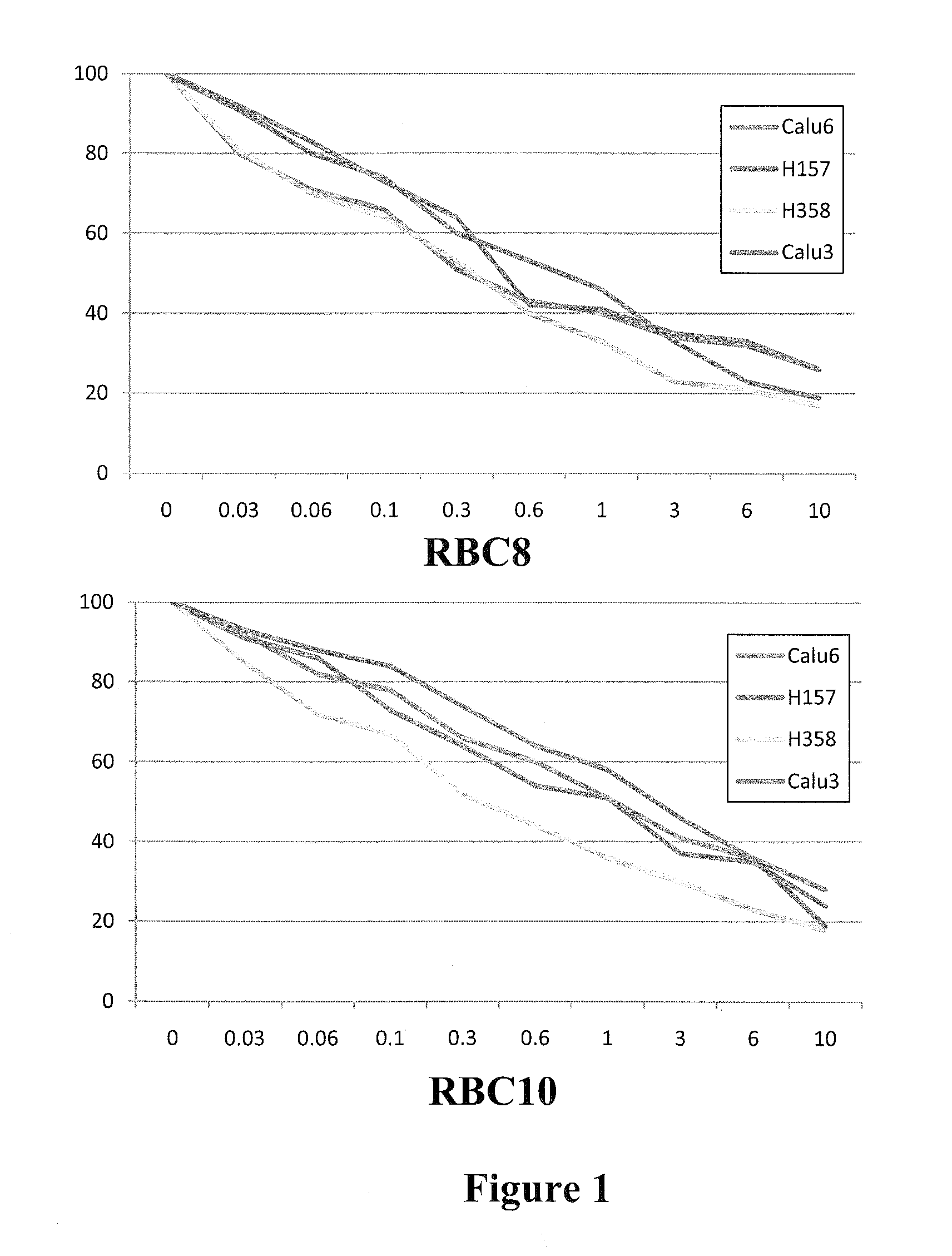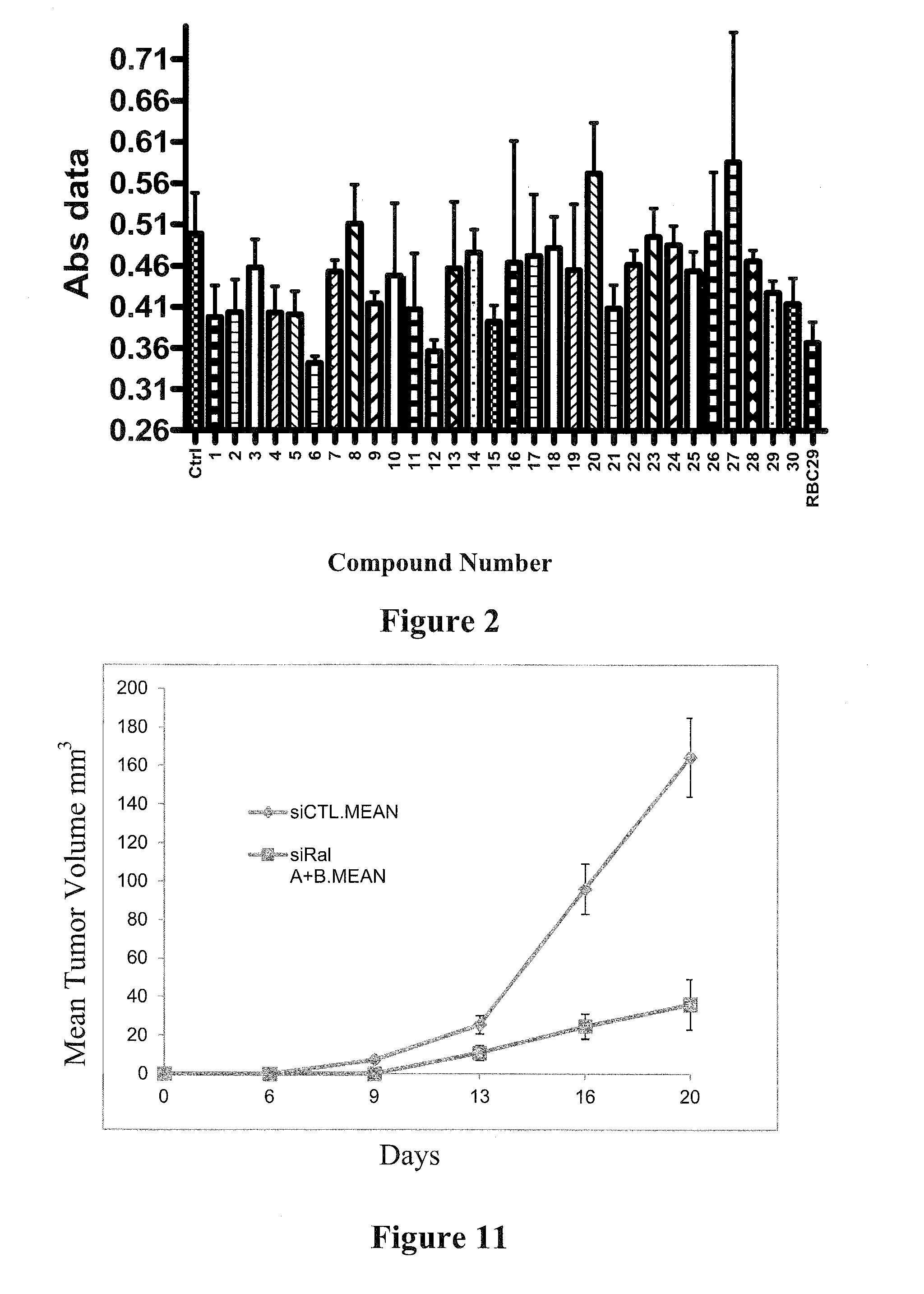Anti-cancer compounds targeting Ral GTPases and methods of using the same
a technology of ral gtpase and anticancer compounds, which is applied in the field of therapeutic compounds, can solve the problems of no clinical trials with ggtis, no successful development of ggtis, and modest inhibitory effects, and achieve the effect of preventing or slowing the growth and metastasis of cancer
- Summary
- Abstract
- Description
- Claims
- Application Information
AI Technical Summary
Benefits of technology
Problems solved by technology
Method used
Image
Examples
example 1
Screening of Putative Ral GTPase Inhibitors
[0115]Because the crystal structure of RalB is not defined, the inventors screened GDP-loaded RalB protein against a 92,167 member encoded bead-based library. The screen was performed as a direct binding assay of FLAG-RalB at 500 nM to pools of beads. Each pool contained multiple copies of encoded immobilized compounds. A visible blue color developed upon FLAG-RalB binding by an ELISA, with mouse anti-FLAG, goat anti-mouse alkaline phosphatase conjugate, and the precipitating substrate BCIP. Blue beads were physically separated and decoded by mass spectroscopy. This search resulted in the identification of eleven compounds for further evaluation.
[0116]The inventors constructed the 3D structure of RalB using threading algorithms from the known RalA crystal structure (Nicely N I, Kosak J, de Serrano V, Mattos C. Crystal structures of Ral-GppNHp and Ral-GDP reveal two binding sites that are also present in Ras and Rap. Structure (Camb) 2004; 1...
example 2
Synthesis of Putative Ral GTPase Inhibitors
[0119]Certain embodiments of the invention are illustrated by the following synthetic schemes.
[0120]
[0121]
synthesis examples
CHEMICAL SYNTHESIS EXAMPLES
[0122]General Procedure A; 3-methyl-1-phenyl-1H-pyrazol-5(4H)-one UC-E1: A solution of ethyl acetoacetate (9.02 mL, 71.2 mmol, 1.1 equ.) in ethanol (130 mL) was treated at 0° C. with phenyl-hydrazine (7.00 g, 64.7 mmol, 1.0 equ.). The mixture was allowed to come to slowly ward to ambient temperature and then heated to 60° C. (3 h). The solvent was removed under vacuum and the residue purified by column chromatography on silica gel (ethyl acetate:hexanes; 1:1) to give 3-methyl-1-phenyl-1H-pyrazol-5(4H)-one (7.60 g, 43.6 mmol, 67%) as a light yellow powder. 1H-NMR (400 MHz) CDCl3: 7.87-7.85 (d, 2H), 7.41-7.37 (t, 2H), 7.19-7.16 (t, 1H), 3.42 (s, 2H), 2.19 (s, 3H), 13C-NMR (100 MHz) CDCl3: 170.5, 156.2, 138.0, 128.8, 125.0, 118.8, 43.0, 17.0; LC / MS-MS: 175.0→77.1 m / z; GS1 and GS2 at 30, DP=56, CE=25, CXP=4, tR=3.52 min.
[0123]1,3-dimethyl-1H-pyrazol-5(4H)-one UC-E2: Following the ‘general procedure A’; ethyl acetoacetate (15.1 mL, 119 mmol, 1.1 equ.) in ethano...
PUM
 Login to View More
Login to View More Abstract
Description
Claims
Application Information
 Login to View More
Login to View More - R&D
- Intellectual Property
- Life Sciences
- Materials
- Tech Scout
- Unparalleled Data Quality
- Higher Quality Content
- 60% Fewer Hallucinations
Browse by: Latest US Patents, China's latest patents, Technical Efficacy Thesaurus, Application Domain, Technology Topic, Popular Technical Reports.
© 2025 PatSnap. All rights reserved.Legal|Privacy policy|Modern Slavery Act Transparency Statement|Sitemap|About US| Contact US: help@patsnap.com



